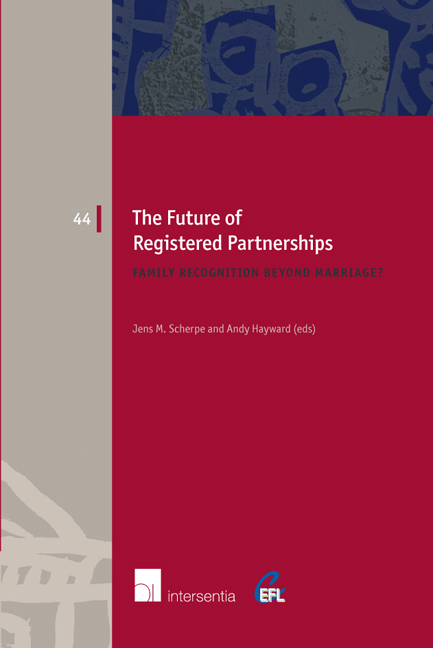Book contents
- Frontmatter
- Foreword
- Preface
- Contents
- List of Contributors
- The Future of Registered Partnerships: An Introduction
- Questionnaire
- Part I Registered Partnerships as a Functional Equivalent to Marriage
- Registered Partnerships in Denmark
- Registered Partnerships in Norway
- Registered Partnerships in Sweden
- Registered Partnerships in Iceland
- Part II Registered Partnerships as an Alternative to Marriage
- Part III Registered Partnerships in a Time of Transition
- Part IV Alternative Models for Registered Partnerships: Beyond Conjugality, Beyond Formality
- Part V Registered Partnerships, Discrimination and Human Rights
- Part VI Comparative Perspective and Conclusions
- Index
- European Family Law Series
Registered Partnerships in Denmark
from Part I - Registered Partnerships as a Functional Equivalent to Marriage
Published online by Cambridge University Press: 22 September 2018
- Frontmatter
- Foreword
- Preface
- Contents
- List of Contributors
- The Future of Registered Partnerships: An Introduction
- Questionnaire
- Part I Registered Partnerships as a Functional Equivalent to Marriage
- Registered Partnerships in Denmark
- Registered Partnerships in Norway
- Registered Partnerships in Sweden
- Registered Partnerships in Iceland
- Part II Registered Partnerships as an Alternative to Marriage
- Part III Registered Partnerships in a Time of Transition
- Part IV Alternative Models for Registered Partnerships: Beyond Conjugality, Beyond Formality
- Part V Registered Partnerships, Discrimination and Human Rights
- Part VI Comparative Perspective and Conclusions
- Index
- European Family Law Series
Summary
HISTORY AND BACKGROUND
BASIC STRUCTURES OF THE LAW ON ADULT RELATIONSHIPS
The primary sources in Danish family law are Acts of Parliament. Although there are some important court decisions concerning the legal relation between spouses, these decisions should only be seen as an interpretation of the legislation. By contrast, the legal situation regarding division of property between unmarried cohabitants is based solely on case law.
Marriage
Since the fifteenth century, the husband was considered head of the family in Denmark. The property rights of the spouses were a kind of community property settlement. But as the spouses were not equal, it was not a settlement like the community property settlement in force today. Only the husband had the right to dispose of the community property.
Important changes in this system were made by legislation in the last part of the nineteenth century and especially in 1925 by the Act of Parliament governing the legal effects of marriage, an Act which – with few amendments – is still regulating matrimonial property law today. The motivation for the reform was to create equality between the spouses as far as economic and personal matters were concerned. The legislation operates through a kind of community property settlement which allows each spouse to deal independently with the property they have acquired before or during the marriage so that each spouse is personally liable for this property to his or her own creditors.
The most important Acts are the Marriage and Matrimonial Causes Act and the Act on Spouses ‘Financial Matters. Division of the family assets is governed by the Act on Division of Spouses’ Assets.
Concerning children, the most important Acts are the Children Act 5 and the Parental Responsibility Act, as subsequently amended.
In 2012, gender-neutral marriage was introduced in Denmark and the new rules of the Marriage and Matrimonial Causes Act and the Act on the Legal Effects of Marriage came into effect on 15 June 2012.
Registered Partnership
In 1989, Denmark was the first country in the world to introduce an Act of Parliament which allowed two persons of the same sex to enter into a registered partnership. The Act came into effect from 1 October 1989.
- Type
- Chapter
- Information
- The Future of Registered PartnershipsFamily Recognition Beyond Marriage?, pp. 19 - 42Publisher: IntersentiaPrint publication year: 2017
- 1
- Cited by

